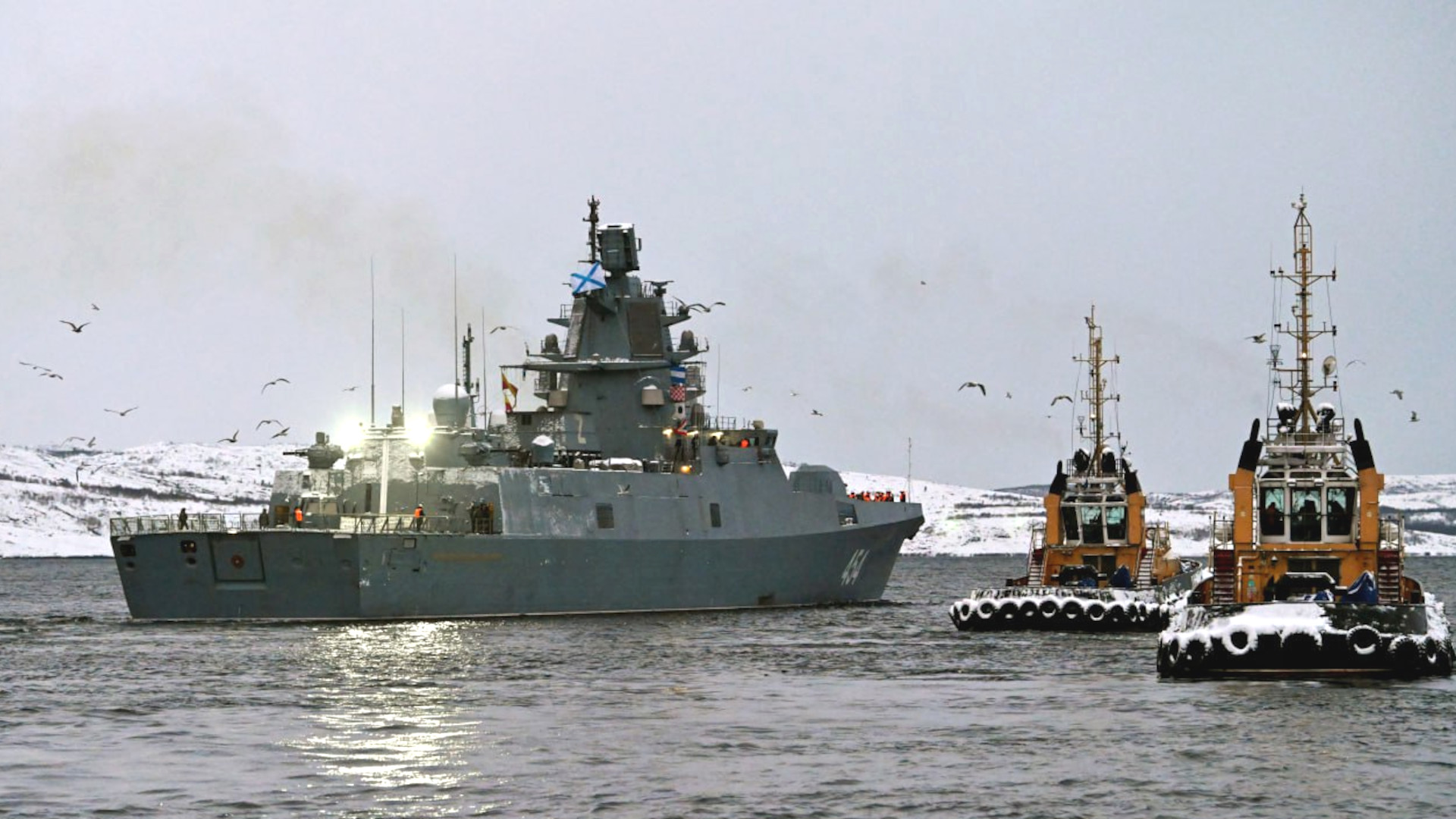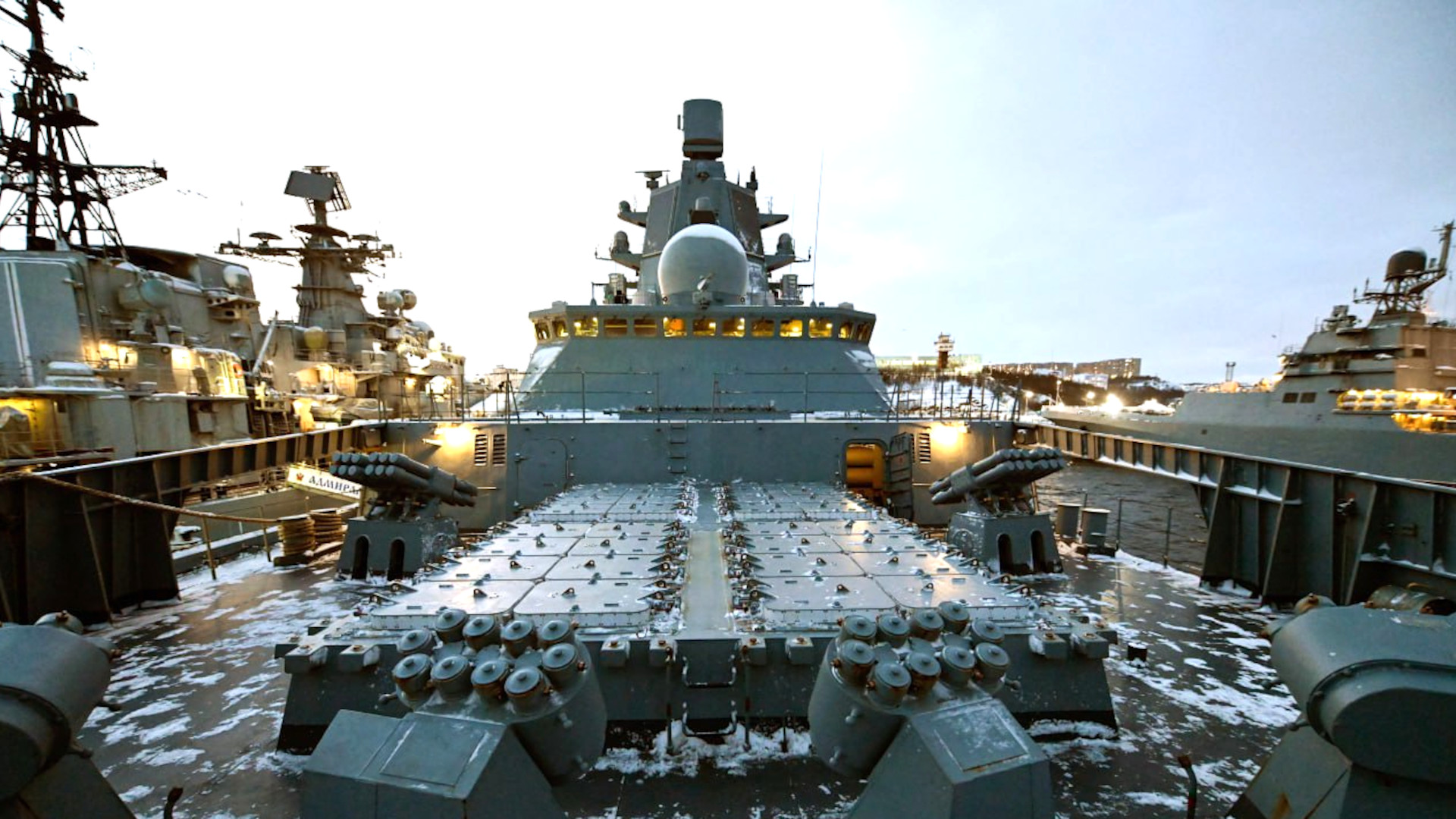The Russian Navy’s first Project 22350 frigate, the Admiral Gorshkov, has set out on a deployment armed, in part, with new Zircon hypersonic cruise missiles, according to officials in that country. In 2020, the Russian government said that the warship had carried out the first ever successful live-fire launch of a Zircon during a drill in the White Sea.
Russian Defense Minister Sergei Shoigu announced Gorshkov‘s deployment, which he said would see the warship sail in the Atlantic and Indian Oceans and the Mediterranean Sea, earlier today during a ceremony. The ship, the full name of which is Admiral Flota Sovetskogo Soyuza Gorshkov, was officially commissioned in 2018 and assigned to the Russian Navy’s Northern Fleet. Gorshkov class frigates are among the service’s most modern surface combatants and the class leader notably conducted an around-the-world voyage in 2019 that saw it visit ports in Africa, Asia, the Caribbean, and Latin America.

“I am sure that such powerful weapons will reliably protect Russia from potential external threats and will help ensure the national interests of our country,” Putin said during the event, which was reportedly conducted at least in part via video conference. The Russian President had said last month that Zircon would be operationally deployed in some capacity. Officials in Russia have said in the past that it expects a number of other types of ships and submarines, including the Russian Navy’s advanced and extremely quiet nuclear-powered Yasen and Yasen-M class submarines, to be able to employ Zircon in the future.
Along with this announcement, a video that the Russian Ministry of Defense released in May 2022 and said showed Gorshkov launching a Zircon missile, has been circulating online today. There have been incorrect claims that it shows a new launch to coincide with the beginning of the ship’s deployment.

Despite this reported operational deployment, details about Zircon (sometimes written Tsirkon) and its capabilities remain limited. The Russian Ministry of Defense said that the example that Admiral Gorshkov fired during the 2020 test reached a peak speed of “more than Mach 8” and traveled a total of 280 miles. The test last May reportedly saw the weapon fly approximately 620 miles (1,000 kilometers), which is in line with claims that Putin had made about its performance in 2019. The Russian President also indicated at that time that the missile would be able to reach a speed of up to Mach 9. Hypersonic speed is typically defined as anything above Mach 5.
Gorshkov‘s commanding officer, Captain Igor Krokhmal, said that it has been loaded with variants of the Kalibr subsonic cruise missile family, which include anti-ship and land-attack types, as well as Zircons, according to Russian state media. Admiral Gorshkov class frigates can fire either of these weapons, as well as Oniks supersonic anti-ship cruise missiles, from an array of 16 multi-purpose vertical launch cells at the bow-end of the ship.

In addition to cruise missiles, Admiral Gorshkov class frigates are armed with a 130mm main gun, a navalized version of the S-350 surface-to-air missile system called Redut, Palash close-in weapon systems, and torpedoes. The Russian Navy currently has three of these warships, with seven more in various phases of construction and fitting out. Six of those future examples are expected to be of an improved subtype with, among other things, twice as many vertical launch system cells.
If Gorshkov has indeed headed out with a loadout that includes some number of Zircon, this would be a significant milestone for that weapon system, which Russian authorities have admitted in the past experienced significant difficulties during development. From an operational perspective, hypersonic cruise missiles present new challenges for enemy forces at sea and on land given that it greatly reduces the amount of time it takes for the weapon to reach its target and similarly limits the amount of time defenders have to react. In addition, hypersonic cruise missiles, especially if they have high degrees of maneuverability, would be very hard to intercept.
It seems clear that the Russian military intends this deployment to be an important show of force in the context of its growing geopolitical isolation over its all-out war on Ukraine, which began in February 2022. U.S. and other NATO naval activity around Europe, including in the Atlantic and the Mediterranean, which are among the places where Gorshkov will reportedly sail, has significantly increased as part of broader efforts, which began in the immediate lead-up to the current conflict in Ukraine, to deter further Russian aggression.

At the same time, while it remains to be seen whether or not Gorshkov or its Zircons will actively participate in the conflict in Ukraine, this seems unlikely. After Russia’s initial large-scale invasion last year, Turkish authorities announced they would block any warships from sailing into the Black Sea from the Mediterranean via the Dardanelles and the Bosporus, as is their right under existing international law.
Gorshkov could technically fire missiles at Ukraine from the Mediterranean, but they would have to fly over one or more NATO members in the process, presenting serious risks. Even if a missile simply fell accidentally onto one of those countries, it would create a major international incident and potentially lead to one of Russia’s newest weapons, or parts thereof, falling into the hands of western intelligence agencies. The war in Ukraine has already provided a goldmine of intelligence on current higher-end Russian weapon systems and other advanced military hardware for the government in Kyiv and its international partners, including the United States.
In addition, if Gorshkov is actually carrying Zircons, it’s not clear how many of the missiles are loaded on the ship or how many the Russian military has available in total. On top of that, there are questions about the reliability of the existing missiles and what the country’s capacity might be currently to produce more. Russia’s defense enterprises, among other things, have been severely hampered by crippling international sanctions imposed over the war in Ukraine. The country’s heavy reliance on foreign electronics in the production of advanced weapon systems has only exacerbated these issues. This is all on top of economic troubles Russia has experienced that predate the conflict, which have often led in the past to the cutting or deferment of major defense programs due to funding limitations.
Still, U.S. officials have cited Zircon, as well as other Russian hypersonic weapon developments, as evidence of that country’s progress in this regard in the past. “We’re not as advanced as the Chinese or the Russians in terms of hypersonic programs,” U.S. Space Force Gen. David Thompson, Vice Chief of Space Operations, said at the Halifax International Security Forum in 2021, pointing in part to a reported Zircon test that year.
All told, if true, while the Russian Navy deploying a ship armed with hypersonic cruise missiles is a major development, it would seem, at least at present, to represent a very limited operational capability.
Contact the author: joe@thedrive.com
